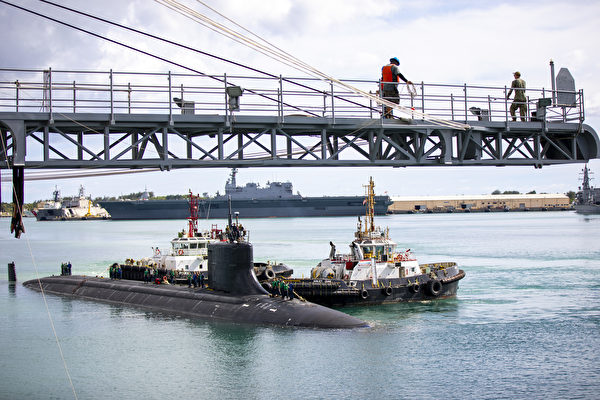On Friday, October 4th, one of the most advanced nuclear-powered submarines in the United States Navy, the “Seawolf” nuclear submarine, arrived in Japan, attracting attention. At the same time, China has been building submarines, attempting to challenge the dominant position of the US Navy. However, Pentagon officials recently confirmed that a Chinese nuclear submarine sank in waters near Wuhan.
A ship observer posted a photo of the Seawolf submarine on X, stating that the US Navy’s “Seawolf” is an attack submarine and the lead ship of its class, and has arrived in Yokosuka, Kanagawa Prefecture, Japan.
According to local Japanese media Kanagawa Shimbun, the US Navy’s Seawolf-class nuclear submarine “Seawolf” entered Yokosuka Base, Yokosuka City, around 10:40 a.m. on October 4. The US magazine Newsweek also reported that the prefectural government has confirmed the visit of the American submarine.
The US Navy has only approved the construction of three Seawolf-class submarines. The Department of Defense has always been tight-lipped about the operations of the US Navy’s most powerful submarines, especially the three advanced and mysterious “Seawolf” class submarines. These nuclear-powered fast-attack submarines are primarily used for conducting intelligence activities and executing special missions.
The Seawolf submarine is the lead ship of the Seawolf-class nuclear submarines. The Seawolf-class nuclear submarines are exceptionally quiet, fast, well-equipped, and equipped with advanced sensors. Each submarine is equipped with eight torpedo tubes, with the torpedo room capable of carrying up to 50 weapons, including land-attack cruise missiles and torpedoes, providing enough firepower to sink enemy fleets or carrier groups.
According to a report from the US Naval Institute, the Seawolf-class submarines were originally developed for deep-water operations to counter Soviet submarines. After the end of the Cold War, these submarines underwent upgrades to carry out sensitive missions. The mysterious Jimmy Carter even has a 100-foot hull extension, providing this submarine with special intelligence and special operations capabilities.
The US Navy has a large fleet of attack submarines, with a total of 53 submarines, all powered by nuclear reactors. These submarines are designed to search and destroy enemy ships, as well as to conduct intelligence missions.
The US Navy frequently deploys attack submarines in the Western Pacific to project power and support allies, deterring China. On September 23 last year, the Virginia-class attack submarine USS Vermont, equipped with 25 torpedoes and 12 cruise missiles, visited Busan, South Korea.
In July 2021, the US Navy simultaneously deployed all three Seawolf-class nuclear submarines—Seawolf, Jimmy Carter, and Connecticut—in the Pacific Ocean.
Underwater military capabilities have always been a strong suit for the US Navy, but China has been trying to narrow the gap. While China has the world’s largest navy, it only has a small number of nuclear-powered attack submarines.
The Pentagon’s report on Chinese military power released last year showed that as of the end of 2022, China had 48 diesel-powered attack submarines and 6 nuclear-powered attack submarines.
The report stated that China’s development of new attack submarines, surface ships, and naval aircraft aims to counter US and allied assistance to Taiwan in the event of a conflict and achieve maritime superiority within the First Island Chain. The First Island Chain refers to a series of islands from the Japanese archipelago, Taiwan, and the Philippines to the South China Sea.
The Wall Street Journal reported that China has been diversifying its production of nuclear-powered submarines. Previously, related production activities were concentrated in the northeastern city of Huludao, but now production has shifted to the Wuchang Shipyard near Wuhan for manufacturing nuclear-powered attack submarines.
Several US media outlets reported on September 26, based on information from the Pentagon, that a new Chinese nuclear-powered attack submarine sank in the waters near Wuhan this spring. Subsequently, a Pentagon spokesperson confirmed that the submarine sank next to the dock. It is currently unclear whether the submarine was carrying nuclear fuel.
A senior US defense official stated that the Chinese navy is trying to cover up the fact that its first new type of nuclear-powered attack submarine sank at the dock, which is not surprising.
Su Ziyun, Director of the Strategic and Resource Department of the Taiwan Institute for National Defense and Security Studies, told Epoch Times that the gap between American and Chinese submarines is currently one generation apart (10 years), mainly in terms of mechanics. However, in the future, the gap will widen to about two generations because China’s advanced chips are now blocked, and its chip technology is stuck at the level of 20 years ago.
“So the future decisive battle point between Western democratic countries and China lies in electronic technology, especially advanced chips. Whether China can obtain or break through advanced chip technology. In this way, China will be left further and further behind.”

